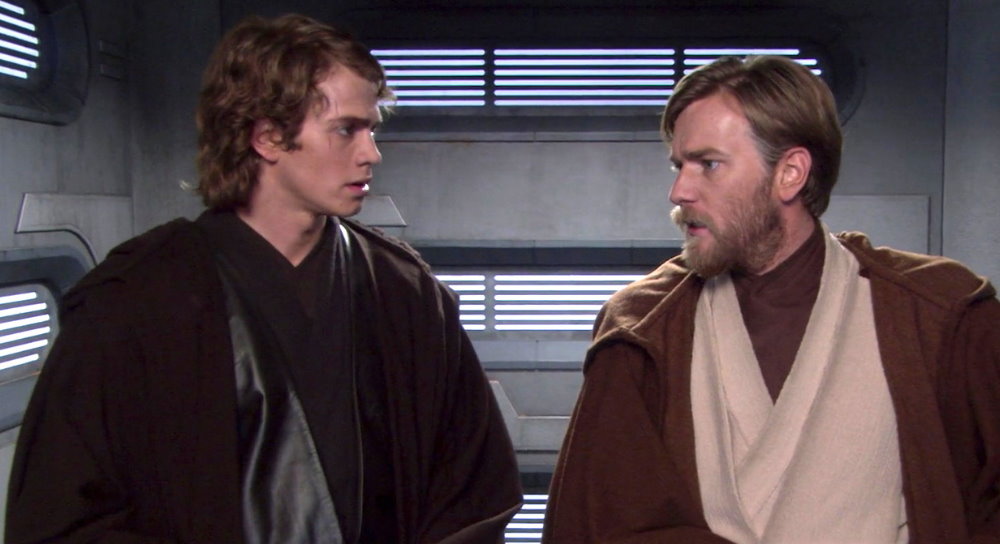Talking with EW about his 2005 novelisation of Revenge of the Sith, author Matthew Stover reembers a fateful meeting at Skywalker Ranch with the Maker George Lucas, a panic attack that hit Stover after signing the contract to write the novel and how the EU inspired that still-every-bit-as-incredible novelisation.
Star Wars: Revenge of the Sith: Episode III (Deluxe Edition) author’s note, by Matthew Stover
To my best recollection, I met the man in January 2004. It was my third time out at Skywalker Ranch. (The other two visits were for story conferences for the New Jedi Order and Clone Wars publishing projects, respectively.) Each of these meetings happened in different rooms in different buildings, and I struggle with keeping them straight.
I have an idea that this one was in an executive conference room on the second floor of the main house, because I remember being escorted through a big hall on the way, past a table that held a genuinely vast, highly detailed scale model of a Victory-class Star Destroyer that someone had given to him as a gift. It was maybe eight or ten feet long and had been built entirely of some preposterous number (Thirty-five thousand? Or more?) of flat gray LEGO bricks. It was among the niftiest pieces of painstaking craftsmanship I have ever seen.
I wish now that I’d taken more time to really look it over — because it was genuinely amazing — but right then I had no attention to spare. This meeting they were walking me into would be the biggest thing that had ever happened in my professional career. I had spent days preparing, and there was no space in my brain for anything else.
Because I had this tricky idea.
It had come to me during the panic attack I’d suffered after signing the contract to write this novelization, which had ignited because I’d foolishly committed to write the keystone in the arch of the Skywalker saga for the biggest audience of my career — and the entire Star Wars – loving universe would be hoping for a thrilling space opera, despite the plain fact that every main plot point had been spoiled for decades.
Add the challenge of writing a novelization without ever seeing the final movie, because the movie wasn’t done and wouldn’t be out before the book went to the printer. I would be armed with only the script and the collective Lucasfilm knowledge of Star Wars.
What saved me then was my early training.
More than twenty years before I signed that contract, I’d had the good fortune to study theatre history under a professor who was an authority on ancient Greek drama. Every single one of the great Greek tragedians had faced exactly my trouble — their audience knew the story going in— and they had some tricks they would pull to make their plays dramatic anyway. I figured I could steal a couple of these for this book.
The more I thought about Greek tragedy, the better it seemed to fit. The classical tragedies were drawn from Greek mythology and legend, right?
Also — if I needed any further excuse — ancient Greek tragedies were traditionally performed as single acts without intermissions, like modern movies, and they were usually presented in actual, no kidding, wait for it . . . trilogies.
I mean, come on. How could I resist?
I hoped to present the story explicitly as a tragic myth, with language and style more formalized and darker in tone than people generally expect from Star Wars fiction. After all, I intended to argue that this story is special. It’s different from any other Star Wars story — not only because it’s the final film (or so we thought at the time), but because this story is the true foundation that underlies all the rest, and it should feel different from the very first page.
But evoking the Greek tragedies was only part of my idea, and I expected that part to be an easy lift, for the reasons I sketched above. The rest, however, was gnawing holes in my stomach lining, because I wanted to fold in elements of the larger Star Wars Expanded Universe (EU). The EU was the catch-all name at the time for all the licensed Star Wars media, including hundreds of novels for all ages, tabletop and digital RPGs, comics, and even (if memory serves) a black-and-white newspaper strip from the 1980s.
I desperately needed EU material to make this story work. Not because the EU had been part of my life ever since Splinter of the Mind’s Eye, and definitely not because it’d be extremely cool to incorporate elements of those stories into this novelization. (Okay, it was cool as hell, but that wasn’t the reason I needed it.)
Mostly it was part of the dodge to skate around my “not knowing what the film would actually look like” issue. Not having that knowledge, I would instead lean on one thing that literature just plain does better than film. In a film, you watch a character experience interesting stuff; in a book, you can be that character while they experience the interesting stuff. You can see what they see, feel what they feel, and think what they think.
This was where the EU came in. It’s all about context. I figured that whatever emotional power this book could generate would spring from how well we know these characters and how much we love them. Those of you who have focused mainly on the films through the years might find it hard to imagine just how deeply some readers know this material and just how important it is to them.
They have history. They’re invested. When something reminds Obi-Wan of Jabiim, the readers know that grim tale. They lived through it with these characters. Longtime readers have followed these folks through decades of drama featuring brain-melting horrors, unbreakable friendships, and an astonishing amount of stuff that can crush your heart and make you laugh in the same story.
These readers have been through a lot with these people.
I genuinely believed that I needed the EU to make this story work as a novel. It would give the story heft and texture. It would let me touch on where these people come from and where most of them are going to end up, and it would let me weave this specific narrative and its implications into the wider “historical” context of the whole galaxy far, far away. I also wanted to find a way to share with more casual readers — the vast majority — some of the depth-of-field immersion that the longtime readers get to experience.
So my escort walked me into the room, and introductions were made, and I’m pretty sure I must have stammered something about how privileged I felt to have been tabbed for the project, but I honestly don’t remember. I had my mind on the pitch. Alongside Mr. Lucas was Howard Roffman (the big cheese at Lucas Licensing), the editorial team from Lucasfilm, and my publisher from Del Rey — all of whom I’d spent the last evening sounding out how to best present my pitch.
So here I am. My big moment. We settle into a beautiful cream-leather lounge set in a breakout area at one end of the conference room. I’m in the armchair with my notes on the ottoman in front of me; Mr. Lucas is on the love seat. Somebody fires up a tape recorder so I don’t have to take notes, and I ease into my pitch.
My plan had been to lead with some topics I’d prepared to know whether he agreed with my approach to them: Jedi philosophy, the nature of the Force, the implications of the Chosen One prophecy — stuff like that. The meeting’s scheduled for two or three hours, and halfway through, I’ve covered only five or six (out of about thirty) of those topics — there is a lot of never-published Jedi lore in that man’s head. I can’t wait any longer to start the scary part of my argument. I screw my courage to the sticking place, but even so, I’m too nervous to just roll it out without first dipping a toe in the water.
“So . . . going forward, when I’m into, you know, the actual writing,” I begin, desperately faking a mild oh-by-the-way tone, “how close do you want me to stick to the script? Are you looking for a scene-for-scene rendering? Like, for example, do you want me to use your dialogue, or — ”
He cuts me off with a hand wave and proceeds to demonstrate one of the reasons George Lucas grew up to be, well, George Lucas. The brand name. The legend we all know him to be. To this day, I can see the twinkle in his eye and hear the chuckle in his voice.
“Don’t worry about that stuff. As long as you don’t violate the story, do whatever you want,” Mr. Lucas says straight to my astonished face. “Just make it good.”
Blinking and gaping while a one-thousand-voice choir of angels roared the “Hallelujah Chorus” inside my brain, I manage to vow, “I will absolutely give it everything I’ve got.”
That’s the story of my entire pitch. All of it. I never even had to bring anything else up.
Which could have been the punch line of this story, except for one salient feature: In all the days I’d spent working out arguments to convince them to let me tell this story my way, I’d entirely neglected to work out how I should go about making “my way” actually, you know, work.
I had no plan.


